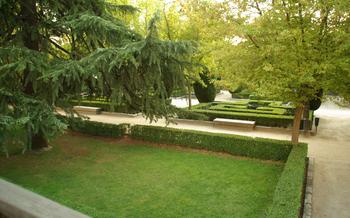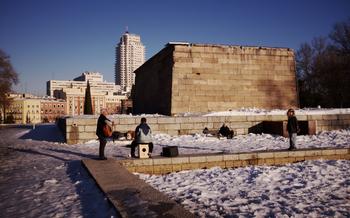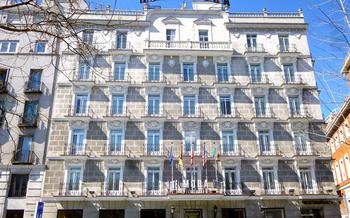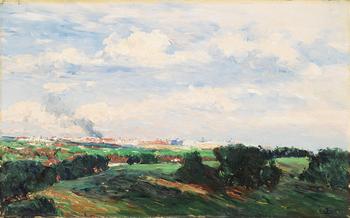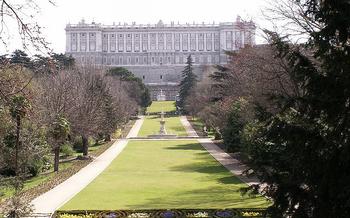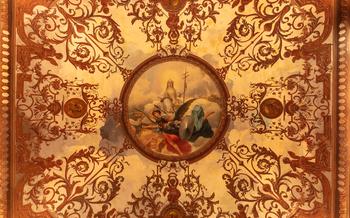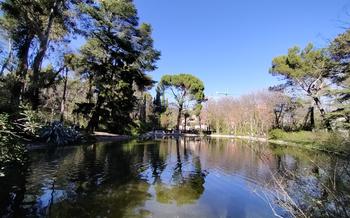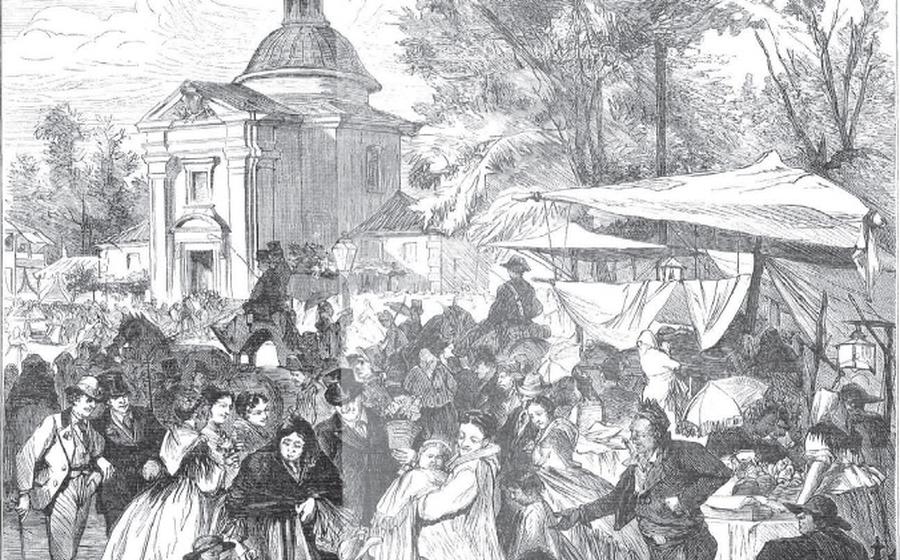
Hermitage of San Antonio de la Florida
- The Hermitage of San Antonio de la Florida: A Hidden Gem in Madrid
- Location and Transportation
- Opening Hours and Admission
- Exploring the Exterior
- Stepping Inside the Hermitage
- Marveling at the Frescoes of Goya
- The Main Altarpiece and Its Significance
- Other Notable Works of Art
- The Hermitage's Connection to Goya's Personal Life
- The Hermitage's Role in Spanish History
- Special Events and Exhibitions
- Tips for Photographers
- Tips for Visitors with Disabilities:
- Insider Tip: The Best Time to Visit
The Hermitage of San Antonio de la Florida: A Hidden Gem in Madrid
Tucked away amidst the vibrant streets of Madrid lies a hidden gem that has captivated art enthusiasts and history buffs alike: the Hermitage of San Antonio de la Florida. This 18th-century hermitage, dedicated to Saint Anthony of Padua, stands as a testament to the artistic prowess of Francisco Goya and the rich cultural heritage of Spain. Built in the Rococo style, the hermitage boasts an unassuming exterior that belies the treasures it holds within. Its charming facade, adorned with intricate carvings and sculptures, hints at the artistic wonders that await inside.
The hermitage was commissioned by King Charles III and designed by the renowned architect Pedro de Ribera. Constructed between 1792 and 1798, it was originally intended as a place of worship for the nearby royal palace. However, it soon gained fame for its stunning frescoes by Francisco Goya, making it one of the most significant religious sites in Madrid and a must-visit destination for any traveler seeking an authentic Spanish experience.
Location and Transportation
The Hermitage of San Antonio de la Florida is located in a charming neighborhood on the outskirts of Madrid, at the following address: Glorieta de San Antonio de la Florida, 5, 28008 Madrid, Spain. To reach the hermitage, you can take advantage of Madrid's excellent public transportation system. The closest metro station is Príncipe Pío, served by Line From there, it's a short walk of about 10 minutes. Alternatively, you can hop on bus number 31, 33, 39, or 65, which all stop nearby. If you prefer the convenience of a taxi, simply provide the address to your driver, and they will take you straight to the hermitage.
In the vicinity of the hermitage, you'll find several other notable attractions that you can combine into a delightful day trip. Just a stone's throw away is the Royal Palace of Madrid, a magnificent architectural masterpiece that once served as the official residence of Spanish royalty. You can also visit the Temple of Debod, an ancient Egyptian temple that was transported to Madrid and meticulously reconstructed in its current location. The Sabatini Gardens, with their serene atmosphere and beautiful landscaping, offer a tranquil retreat from the hustle and bustle of the city.
Opening Hours and Admission
The Hermitage of San Antonio de la Florida is open to the public from Tuesday to Sunday, with varying hours depending on the time of year. During the summer months (April to September), it is typically open from 9:30 am to 1:30 pm and 5 pm to 8 pm. In the winter months (October to March), the hours are usually from 9:30 am to 1:30 pm and 4 pm to 7 pm.
Admission to the hermitage is free of charge, making it an accessible attraction for visitors of all budgets. However, donations are gratefully accepted to help with the ongoing preservation and maintenance of this historic site.
Guided tours of the hermitage are available in both English and Spanish and are highly recommended for those who want to learn more about its history, architecture, and frescoes. Tours typically last for around 45 minutes and cost a nominal fee.
Exploring the Exterior
The Hermitage of San Antonio de la Florida boasts a captivating exterior facade that immediately draws the eye. Its vibrant colors and intricate ornamentation create a striking visual impression. The main entrance features a stunning arched gateway adorned with intricate carvings and delicate moldings. Above the entrance, a beautiful rose window with stained glass panels adds a touch of ethereal beauty. The exterior walls are adorned with colorful ceramic tiles depicting various religious scenes, adding to the overall charm of the hermitage.
As you walk around the exterior, take note of the various sculptures and inscriptions that adorn the walls. These sculptures depict religious figures and scenes, each with its own unique story to tell. Be sure to take a moment to admire the intricate details and craftsmanship of these artworks, which contribute to the overall splendor of the hermitage's exterior.
Don't forget to capture the beauty of the hermitage through photography. The vibrant colors and unique architectural features of the exterior make for stunning photographs. Find the best angles to showcase the hermitage's grandeur and don't hesitate to experiment with different compositions to create memorable shots.
Stepping Inside the Hermitage
Upon entering the Hermitage of San Antonio de la Florida, visitors are immediately struck by the contrast between its humble exterior and the vibrant, awe-inspiring interior. The small, single-nave structure is bathed in a warm, ethereal light that seems to emanate from within. The walls and ceiling are adorned with an array of intricate frescoes, each telling a biblical tale or depicting a scene from the life of Saint Anthony of Padua. The overall effect is one of grandeur and devotion, creating a sense of awe and reverence within the sacred space.
The layout of the interior is simple yet elegant, with a central nave flanked by two side chapels. The nave is dominated by the main altarpiece, a stunning work of art that commands attention with its intricate carvings and vibrant colors. Above the altar, the dome of the hermitage is adorned with a breathtaking fresco depicting the Assumption of the Virgin Mary, surrounded by a host of angels. The overall atmosphere within the hermitage is one of tranquility and peace, inviting visitors to pause and reflect on the spiritual significance of the space.
Marveling at the Frescoes of Goya
The Hermitage of San Antonio de la Florida is renowned for its breathtaking frescoes, painted by the legendary Spanish artist Francisco Goya. These frescoes, executed in the late 18th century, are considered masterpieces of Spanish Baroque art and offer a glimpse into Goya's unique style and artistry.
Goya's frescoes adorn the hermitage's dome and walls, depicting various scenes from the life of Saint Anthony of Padua. The artist's use of vibrant colors, dramatic lighting, and dynamic compositions creates a sense of movement and energy that captivates the viewer. The frescoes showcase Goya's mastery of perspective and his ability to convey emotion and narrative through his brushstrokes.
One of the most striking frescoes is the depiction of Saint Anthony preaching to the fish, where the artist portrays the saint surrounded by a multitude of attentive fish, each with its own distinct expression. Another notable fresco portrays the saint healing the sick, showcasing Goya's compassionate and empathetic portrayal of human suffering.
Goya's frescoes at the Hermitage of San Antonio de la Florida are not only beautiful works of art but also significant historical and cultural artifacts. They offer insights into the religious beliefs and practices of 18th-century Spain and stand as testaments to Goya's genius and his enduring influence on Spanish art.
The Main Altarpiece and Its Significance
The main altarpiece of the Hermitage of San Antonio de la Florida is a stunning masterpiece that commands attention as soon as you step inside. Crafted with intricate detail and meticulous artistry, the altarpiece is a testament to the skill and devotion of its creator.
The altarpiece's central panel depicts the Virgin Mary, resplendent in her heavenly glory. She is surrounded by a host of cherubs and angels, their wings outstretched in adoration. The Virgin's serene countenance and gentle gaze evoke a sense of peace and tranquility, inviting the viewer to contemplate her divine presence.
The altarpiece's materials are as impressive as its design. The figures are carved from the finest alabaster, their smooth, translucent surfaces catching and reflecting the light. The vibrant colors of the paintwork, still remarkably well-preserved after centuries, add to the altarpiece's grandeur.
Beyond its aesthetic beauty, the altarpiece holds deep religious and historical significance. It was commissioned by King Charles III in 1798 as a tribute to Saint Anthony of Padua, the patron saint of the hermitage. The altarpiece's central panel is believed to have been painted by Goya himself, adding to its value and importance.
The altarpiece stands as a testament to the enduring power of faith and devotion. Its exquisite craftsmanship and religious symbolism make it a must-see for anyone interested in art, history, or spirituality.
Other Notable Works of Art
Complementing the frescoes by Goya, the Hermitage of San Antonio de la Florida boasts a collection of other significant artworks that contribute to its artistic and historical value. Among these are sculptures, paintings, and decorative elements that reflect the diverse artistic styles and influences that have shaped the hermitage over the centuries.
One notable sculpture is the "Ecce Homo" by the renowned Spanish artist Luis Salvador Carmona. This poignant depiction of Christ bound and crowned with thorns evokes a profound sense of suffering and compassion. The sculpture's intricate details and expressive features showcase Carmona's mastery of the Baroque style.
Another highlight is the "Virgin of Solitude" painting by the artist Juan Gómez de Mora. This beautifully rendered portrayal of the Virgin Mary exudes an ethereal elegance, with her sorrowful gaze conveying a sense of profound contemplation. The painting's soft colors and delicate brushwork exemplify the artist's skill in capturing the essence of religious devotion.
Furthermore, the hermitage is adorned with decorative elements that contribute to its overall aesthetic charm. These include intricate carvings, ornate moldings, and colorful tiles that reflect the artistic trends of the 18th century. Each decorative detail adds depth and character to the interior, creating a harmonious blend of artistic expression.
The Hermitage's Connection to Goya's Personal Life
The Hermitage of San Antonio de la Florida held a special significance in the life of Francisco Goya, one of Spain's most renowned artists. It was here that Goya chose to be buried, a testament to the deep connection he felt with this sacred space.
Goya's relationship with the hermitage began in 1798 when he was commissioned to paint the frescoes that adorn its walls. This project marked a turning point in his career, allowing him to showcase his exceptional talent and establish himself as a leading figure in the art world.
Goya's personal connection to the hermitage extended beyond his artistic endeavors. He found solace and inspiration within its walls, often seeking refuge from the tumultuous events of his time. The hermitage became a place of contemplation and reflection, where he could connect with his inner self and find peace amidst the chaos of the outside world.
Goya's decision to be buried at the Hermitage of San Antonio de la Florida speaks volumes about the profound impact it had on his life. He wished to be laid to rest in a place that held such deep meaning for him, surrounded by the beauty and serenity that had brought him so much comfort and inspiration.
The Hermitage's Role in Spanish History
Throughout its existence, the Hermitage of San Antonio de la Florida has played a significant role in Spanish history. It initially served as a place of worship for the surrounding community. However, its fame grew in the 19th century, thanks to Goya's renowned frescoes, attracting visitors from all over Spain and beyond.
During the Spanish Civil War, the hermitage suffered severe damage, with many of its frescoes defaced or destroyed. However, after the war, it underwent a meticulous restoration process, returning it to its former glory. This restoration effort was a testament to the enduring significance of the hermitage and its frescoes, which were recognized as a national treasure.
In 1997, the hermitage was declared a Bien de Interés Cultural, or a Site of Cultural Interest, by the Spanish government. This designation highlights the hermitage's exceptional artistic and historical value, making it a protected heritage site. Today, the Hermitage of San Antonio de la Florida stands as a symbol of Spain's rich cultural heritage, attracting visitors who come to admire Goya's masterpieces and experience the tranquility of this sacred space.
Special Events and Exhibitions
Throughout the year, the Hermitage of San Antonio de la Florida hosts a variety of special events and exhibitions that showcase its rich history and cultural significance. These events offer a unique opportunity to experience the hermitage in a new light and learn more about its fascinating past.
Classical music concerts, art exhibitions, and religious celebrations are just a few examples of the events that take place at the hermitage. During these events, visitors can enjoy live performances, admire stunning works of art, and delve deeper into the stories and traditions associated with this sacred space.
To find out about upcoming events and exhibitions, visitors can check the hermitage's official website or social media pages. These platforms provide up-to-date information on event schedules, ticket prices, and any special arrangements that may be required.
Attending a special event or exhibition at the Hermitage of San Antonio de la Florida is a wonderful way to enhance your visit and create lasting memories of this remarkable place. Whether you're a history buff, an art enthusiast, or simply someone who appreciates unique experiences, these events offer something for everyone.
Tips for Photographers
The Hermitage of San Antonio de la Florida is a photographer's paradise, offering a wealth of opportunities to capture its beauty and grandeur. Here are some tips for taking stunning photos of the hermitage:
-
Choose the right time of day: The best time to photograph the hermitage is during the golden hours, just after sunrise or before sunset. This warm, diffused light will enhance the colors of the facade and create a magical atmosphere.
-
Find the best angles: Experiment with different angles to find the most flattering perspective. The hermitage looks particularly striking when photographed from a low angle, emphasizing its imposing dome and intricate details.
-
Use a tripod: A tripod will help you stabilize your camera and avoid blurry photos. This is especially important when shooting in low-light conditions or when using a telephoto lens.
-
Pay attention to reflections: The hermitage's frescoes are delicate and can be easily damaged by flash photography. To avoid reflections, use a polarizing filter or shoot at an angle to the glass.
-
Experiment with different lenses: A wide-angle lens can be used to capture the entire facade of the hermitage, while a telephoto lens can be used to zoom in on the details of the frescoes and sculptures.
With a little patience and creativity, you can capture stunning photos of the Hermitage of San Antonio de la Florida that will preserve its beauty for years to come.
Tips for Visitors with Disabilities:
The Hermitage of San Antonio de la Florida is committed to providing an accessible and enjoyable experience for all visitors, including those with disabilities. The entrance to the hermitage is wheelchair-accessible, and there are designated parking spaces for visitors with disabilities located nearby. Once inside, visitors can find accessible restrooms, as well as ramps and elevators to navigate the different levels of the building. In addition, the hermitage offers guided tours that are tailored to the needs of visitors with disabilities. These tours are available upon request and can be customized to accommodate specific needs. Visitors can also request assistance from the staff if they require any additional support or accommodations during their visit. The Hermitage of San Antonio de la Florida is a beautiful and historic site that everyone should have the opportunity to experience. With its accessible features and supportive staff, the hermitage welcomes visitors of all abilities to come and explore its many treasures.
Insider Tip: The Best Time to Visit
The Hermitage of San Antonio de la Florida offers a tranquil and intimate experience, especially if you visit at the right time. To avoid the crowds and fully appreciate the beauty of the hermitage, consider visiting during off-peak hours, such as early in the morning or late in the afternoon. These times provide softer, more natural lighting, which is ideal for capturing stunning photos.
If you're particularly interested in experiencing the hermitage's serene atmosphere, plan your visit during the shoulder season (spring or autumn) when the weather is pleasant, and there are fewer tourists. This allows you to wander through the garden, admire the frescoes, and soak in the tranquility of this hidden gem without feeling rushed.
For those seeking a truly unique experience, consider attending one of the special events or exhibitions occasionally held at the hermitage. These events often feature live music, art installations, or cultural performances that bring the hermitage to life in new and exciting ways. Check the official website or social media pages for upcoming events and plan your visit accordingly.
Remember, the best time to visit the Hermitage of San Antonio de la Florida is when you can fully immerse yourself in its beauty and history without distractions. Whether you prefer the solitude of off-peak hours, the tranquility of the shoulder season, or the vibrancy of special events, there's a perfect time to discover the magic of this hidden gem in Madrid.

